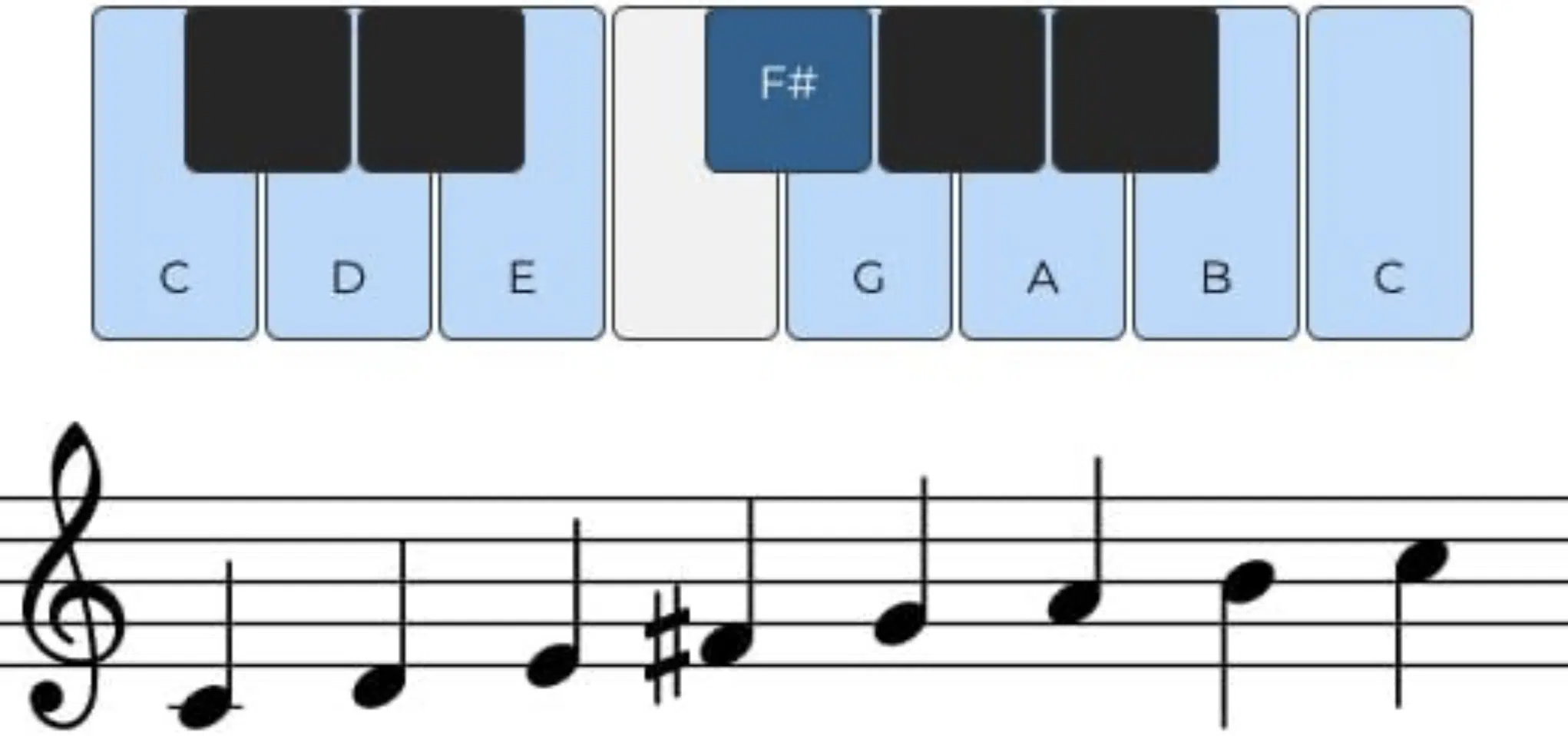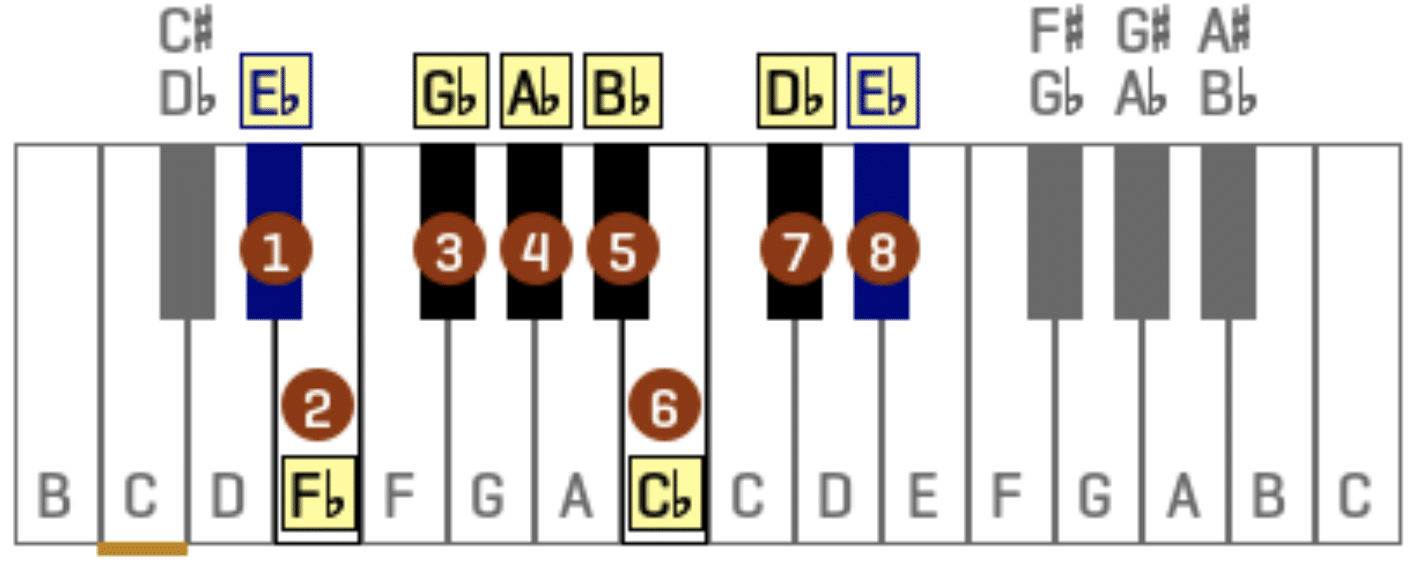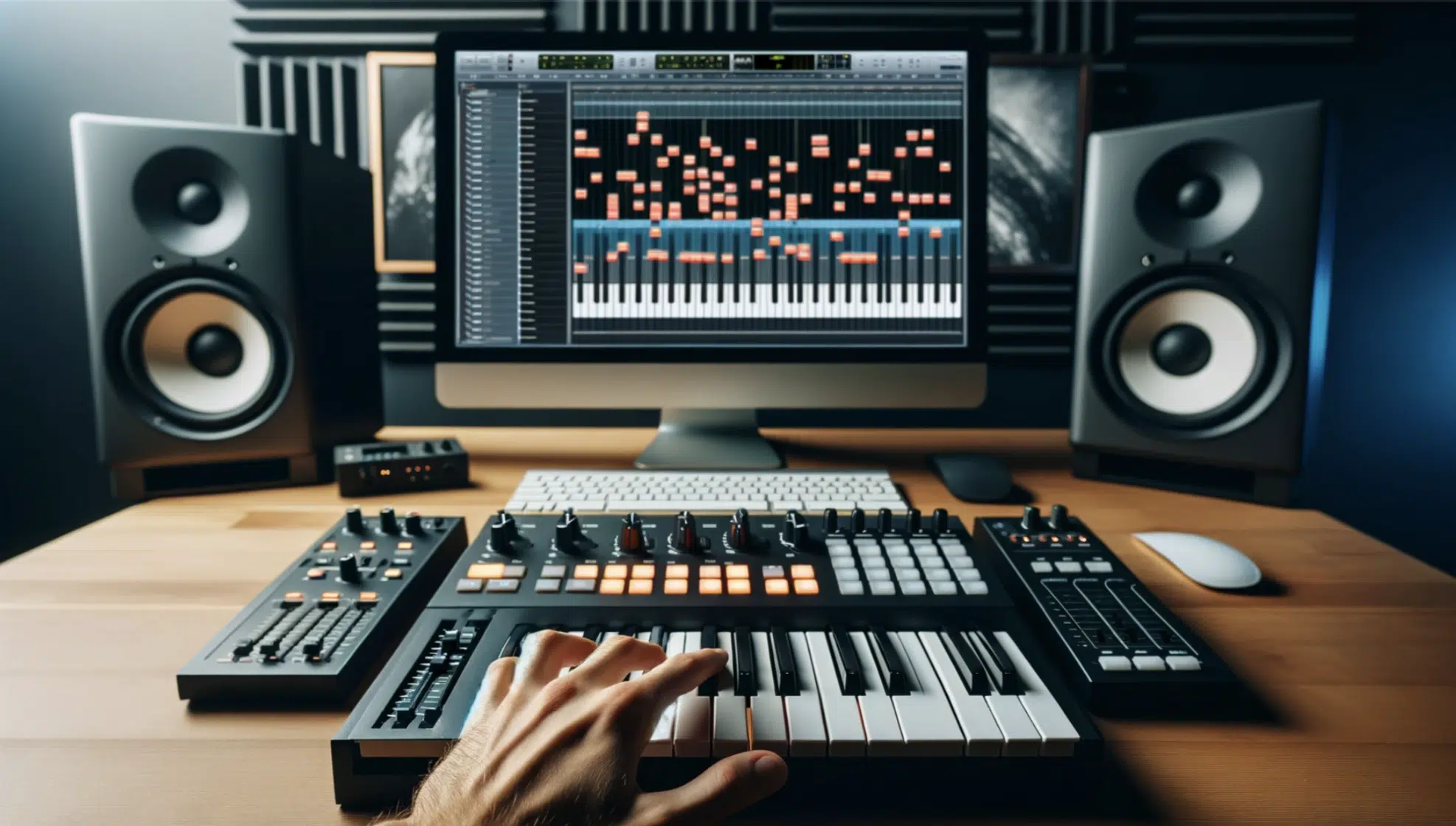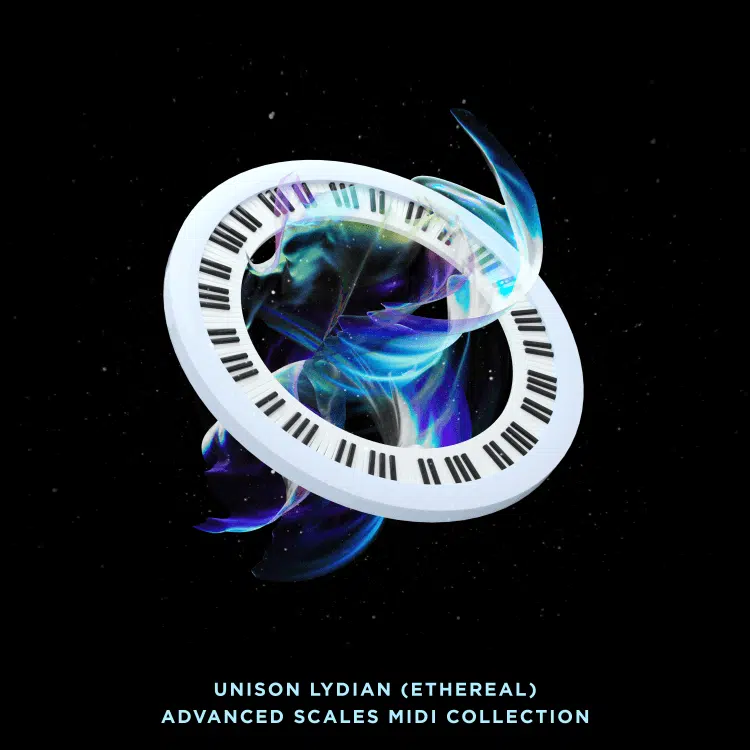The Lydian scale is a fascinating and unique element in music theory, known for its enchanting and ethereal qualities.
It can transform a simple melody into a captivating piece and add an otherworldly charm to chord progressions.
As well as being a vital tool for creativity, the Lydian scale offers a fresh perspective compared to traditional major scales.
It can enable you to explore new sonic landscapes and expand your skills.
So, as a music producer, it’s important to know all about the Lydian scale to make your tracks shine.
In today’s article, we’ll break down:
- Everything you need to know about the Lydian scale ✓
- Comparing Lydian and major scales ✓
- Intricacies of the Lydian mode ✓
- Lydian mode vs. other musical modes ✓
- The F, C, G, and E Lydian scales ✓
- Importance of scale degrees ✓
- Role of the augmented fourth ✓
- Modal scales & strategies ✓
- Crafting unique chord progressions ✓
- Tonal variations in Lydian mode ✓
- Practical uses in music production ✓
- Much more ✓
By the end of this article, you’ll know the Lydian scale like the back of your hand, helping you to incorporate its magical qualities like a professional.
Therefore, your tracks will shine with unique sounds and instantly captivate your audience’s attention.
So, let’s dive in…
Table of Contents
- What is the Lydian Scale?
- The Lydian Scale & The Major Scale
- The Lydian Mode: Breaking it Down
- Lydian Mode vs Other Musical Modes
- Exploring Different Lydian Scales
- Experimenting with the Lydian Scale in Your Own Music
- Bonus: The Unison Lydian (Ethereal) Advanced Scales MIDI Collection
- The Lydian Scale: Final Thoughts
What is the Lydian Scale?

The Lydian scale, a mesmerizing aspect of music theory, captivates with its unique tonal quality.
Essential in the toolbox of digital music producers, the Lydian scale offers a distinct sound that sets it apart from traditional scales.
At its essence, the Lydian scale is a seven-note scale, characterized by a particular sequence that includes a raised fourth degree.
For example, in the C Lydian scale, the notes are C, D, E, F#, G, A, and B.
This raised fourth (F# in this case), different from the F in the C major scale, gives the Lydian scale its unique and ethereal quality.
The Lydian scale’s enchanting sound is a result of this subtle yet significant alteration from the major scale.
Embracing the Lydian scale in music production leads to the creation of captivating and innovative tracks.
Whether it’s the F Lydian scale with its notes F, G, A, B, C, D, and E, or the G Lydian scale with G, A, B, C#, D, E, and F#, each variation maintains the scale’s signature dreamlike essence.
The Lydian Scale & The Major Scale

The relationship between the Lydian scale and the major scale is a fundamental aspect of music theory, rich in both its complexity and its musicality.
The major scale, such as the C major scale (C, D, E, F, G, A, B), forms the backbone of much of Western music with its well-known sequence of whole and half steps.
The Lydian scale introduces a captivating alteration.
This single variation 一 the raised fourth degree (F# in C Lydian as opposed to F in the C major scale) 一 imparts a brighter, more ethereal quality to the Lydian dominant scale.
It distinguishes it from the more grounded major scale.
The major scale, or Ionian mode, is often seen as the default or ‘standard’ in music, providing a familiar sonic foundation from which other scales, like the Lydian, deviate.
The shift from the perfect fourth in the traditional major scale to the augmented interval fourth in the Lydian scale is more than just a theoretical curiosity.
It offers a distinct sonic palette and can help impart some originality.
For instance, in the F major scale (F, G, A, Bb, C, D, E), the Bb creates a different mood compared to the B natural in the F Lydian scale (F, G, A, B, C, D, E).
This raised note in the Lydian scale adds a sense of openness and forward momentum 一 contrasting with the more resolved and stable feel of the major scale.
For digital music producers and songwriters, understanding and utilizing the differences between the Lydian and major scales can help you create unique and engaging tracks.
Just remember that the Lydian scale, with its raised fourth, lends itself to creating atmospheric, dreamlike soundscapes that can elevate a composition.
NOTE: A whole-step equals a tone and a half-step equals a semitone. In the C Lydian scale, reference the above example, the sequence is C, D, E, F#, G, A, B.
The Lydian Mode: Breaking it Down

The Lydian mode, a pivotal concept in music theory, stands as a distinct and captivating scale among the various musical modes.
Defined by its unique structure, the Lydian mode is essentially a major scale but with a critical twist: its fourth degree is raised by a half-step.
This defining feature of the Lydian mode sets it apart, offering a sound that is both mystical and uplifting.
Let’s take the F Lydian mode, for example…
In the F Lydian mode, the scale comprises the notes F, G, A, B (raised fourth), C, D, and E, contrasting with the F major scale where the fourth note is Bb.
The raised fourth degree in the Lydian mode not only distinguishes it from the major scale (also known as the Ionian mode) but also infuses it with a unique character.
This character is evident in scales like:
- The C Lydian (C, D, E, F#, G, A, B)
- The G Lydian (G, A, B, C#, D, E, F#)
You can see that the raised fourth (F# in C Lydian and C# in G Lydian) adds a bright, almost mythical quality.
This quality is what makes the Lydian mode so appealing in various music genres, especially in digital music production where its distinct sound can add extra depth.
The Lydian mode allows music producers to venture beyond conventional major scales and explore new musical opportunities.
For example, using the E Lydian mode (E, F#, G#, A, B, C#, D#) can bring an unexpected twist to a melody or chord progression.
It sets the piece apart with its sharpened fourth note, G#.
Lydian Mode vs Other Musical Modes
To master the Lydian mode, it’s beneficial to compare it with other musical modes, each with its distinct characteristics and notes 一 offering a rich tapestry of soundscapes.
-
The Ionian Mode

The Ionian mode, or the major scale, like C Ionian (C, D, E, F, G, A, B), is the most familiar music mode in Western music.
Its balanced and harmonious sound contrasts with the Lydian mode’s (like C Lydian: C, D, E, F#, G, A, B) unique raised fourth.
This single note difference in the Lydian mode creates a brighter, more ethereal quality compared to the grounded and familiar feel of the Ionian mode.
-
The Mixolydian Mode

The Mixolydian mode, such as G Mixolydian (G, A, B, C, D, E, F), has a bluesy feel due to its lowered seventh degree.
When compared to the Lydian mode (like G Lydian: G, A, B, C#, D, E, F#), the Mixolydian mode lacks the raised fourth.
Therefore, the Mixolydian mode results in a sound that is less bright and more grounded 一 leaning towards a blues or rock vibe.
-
The Locrian Mode

The Locrian mode, exemplified by B Locrian (B, C, D, E, F, G, A), is characterized by its diminished fifth.
In turn, the Locrian mode evokes a tense and somewhat dissonant sound.
This contrasts with the Lydian mode’s augmented fourth, which instead adds an uplifting and airy quality to the scale.
-
The Phrygian Mode

The Phrygian mode, like E Phrygian (E, F, G, A, B, C, D), is known for its flattened second degree, offering an exotic or Spanish flavor.
In contrast, the Lydian mode, such as E Lydian (E, F#, G#, A, B, C#, D#), with its raised fourth, produces a brighter, more fantastical sound.
One that is much different from the Phrygian’s earthy and mysterious tonality.
-
The Dorian Mode

The Dorian mode is similar to the minor scale but with a raised sixth.
For example, D Dorian mode (D, E, F, G, A, B, C), provides a jazzy or folk feel.
This differs from the Lydian mode (like D Lydian: D, E, F#, G#, A, B, C#), where the raised fourth creates a more surreal and uplifting mood.
However, it does lack the Dorian mode’s bluesy undertone.
-
The Aeolian Mode

The Aeolian mode, or the natural minor scale, such as A Aeolian (A, B, C, D, E, F, G), is known for its somber and melancholic sound.
In contrast to the Aeolian mode, the Lydian mode, like A Lydian (A, B, C#, D#, E, F#, G#), with its characteristic raised fourth, offers a contrasting soundscape.
One that is more luminous and less grounded than the Aeolian’s reflective and introspective mood.
Each musical mode, with its unique set of notes (not the same notes) and emotional color, contributes to the vast landscape of music.
The Lydian mode, in particular, stands out for its ability to add a touch of brightness and fantasy to any song.
This sets it apart from the more traditional sounds of each other mode.
NOTE: While exploring modal scales and other modes, it’s interesting to note the contrast between the Lydian scale and other scales like the whole tone scale.
The whole tone scale consists of six notes each a whole tone apart 一 offering a completely different harmonic flavor.
Exploring Different Lydian Scales
In its various forms, the Lydian scale provides a fascinating study of how shifting one note can create entirely different musical atmospheres. Let’s dive into the specific characteristics of some popular Lydian scales.
-
F Lydian Scale: A Closer Look
The F Lydian scale, comprising F, G, A, B, C, D, and E, is a prime example of the Lydian mode’s ethereal quality.
This scale’s raised fourth note, B, as opposed to the Bb in the F major scale, offers a sound that is:
- Brighter
- Enchanting
- More uplifting
This particular scale is favored in popular music which requires a sense of openness and innovation.
The classical repertoire of the F Lydian scale can be found in jazz and progressive rock, where its distinct sound creates rich harmonic landscapes.
The augmented fourth, B, in the F Lydian scale, plays a crucial role in defining its unique character 一 setting it apart from the more traditional F major scale.
NOTE: One example that perfectly represents this scale in action is “Dreams” by Fleetwood Mac.
-
C Lydian Scale: Unique Features
The C Lydian scale, with its notes C, D, E, F#, G, A, and B, stands out due to its sharpened fourth degree, F#.
This alteration from the standard C major scale imparts the C Lydian scale with a dreamlike, almost mystical quality.
It’s this quality that has made it a favorite among producers and artists looking to evoke a sense of:
- Wonder
- Intrigue
- Fantasy
In digital music production, the C Lydian scale is often employed to add a layer of complexity and novelty to compositions.
The raised fourth, F#, becomes a pivotal note in creating harmonies and melodies that are both familiar and distinctly otherworldly.
NOTE: “Flying in a Blue Dream” by Joe Satriani is a perfect example of a song that utilizes this scale.
-
G Lydian Scale & E Lydian Scale: Their Distinct Sounds
The G Lydian scale (G, A, B, C#, D, E, F#) and the E Lydian scale (E, F#, G#, A, B, C#, D#) each offer their unique flavor.
- The G Lydian’s raised fourth (C#) 一 Adds a bright and optimistic tone.
- The E Lydian’s G# 一 Imparts a more adventurous and bold sound.
Both scales are exemplary in showcasing the Lydian mode’s versatility.
These scales are often utilized in film scores and ambient music, where their distinct qualities can create specific moods and atmospheres.
For instance, the E Lydian scale might be used to convey a sense of discovery or epiphany 一 while the G Lydian could be more suited to uplifting or inspirational themes.
NOTE: Katy Perry took full advantage of the G Lydian scale’s unique sound in her hit song “E.T.”
Experimenting with the Lydian Scale in Your Own Music

Embracing the Lydian scale to create your own distinct sound can transform your creative process.
Experimenting with scales like the C Lydian or F Lydian not only enhances your understanding of music theory but also opens up new avenues for musical expression.
Incorporating the Lydian scale into your tracks can add a layer of sophistication and allure to your own music through:
- Melodies
- Harmonies
- Chord progressions
Consider, for example, creating a melody in the E Lydian scale (E, F#, G#, A, B, C#, D#) and harmonizing it with chords from the same scale.
This not only solidifies your grasp of the Lydian mode but also allows you to explore its intriguing sonic qualities.
-
Pro Tip: Scale Degrees

Understanding scale degrees is crucial in music theory, and in the Lydian mode, this becomes especially significant.
Scale degrees are specific notes within a scale that are identified by their numerical position.
In the Lydian scale:
- The first degree (root note) 一 Establishes the tonal center.
- The raised fourth 一 Introduces the Lydian’s signature sound.
Each degree of the scale plays a specific role in shaping the overall sound, structure, and feel of the mode.
So, needless to say, mastering scale degrees is very important to creating fluid, harmonically rich tracks that sound professional and pristine.
-
Crafting Unique Chord Progressions

Utilizing the Lydian scale in chord progressions (especially a major chord) offers a fresh perspective in music production.
For example, in the F Lydian scale, a progression like F – B – E – A can highlight the distinctive raised fourth degree.
This will help you create a sound that’s both familiar and intriguingly different.
This approach allows producers to experiment with traditional harmonies while infusing their entire song with the Lydian scale’s unique charm.
Bonus: The Unison Lydian (Ethereal) Advanced Scales MIDI Collection

The Unison Lydian (Ethereal) Advanced Scales MIDI Collection offers a groundbreaking tool for music producers interested in the enchanting world of the Lydian scale.
This collection is an exceptional resource, providing over 1,100 MIDI files that include:
- Scales
- Chords
- Progressions
- Melodies
Yes, all in the Lydian mode.
Known as the “Ethereal scale” and widely used in modern music, the Lydian scale’s bright and majestic qualities are captured perfectly in this pack.
Geared towards both novice and experienced producers, this MIDI collection eliminates the need for extensive music theory knowledge.
It gives you instant access to high-quality Lydian scales and their variations.
The pack includes a vast array of MIDI files that can be used with leads, plucks, pads, keys, and arpeggios 一 making it a versatile addition to any producer’s toolkit.
With these tools, you can create tracks that stand out and include the Lydian scale’s unique, complex qualities.
This invaluable collection is an essential asset for anyone looking to explore the Lydian scale’s potential in digital music production.
Download the Unison Lydian (Ethereal) Advanced Scales MIDI Collection Now
The Lydian Scale: Final Thoughts
The Lydian scale is an invaluable tool for digital music producers of all styles.
It offers a unique blend of ethereal and mystical qualities that can completely transform any track.
Through this exploration of the Lydian scale, its modes, and its variations across different keys, we’ve unlocked the secrets to creating captivating, innovative music.
Whether you’re experimenting with the F, C, G, or E Lydian scales, or experimenting with resources like the Lydian MIDI collection discussed above, the possibilities are endless.
With this knowledge, you’re now equipped to infuse your music with the magical essence of the Lydian scale 一 helping your music blow the competition out of the water.
Until next time…







Leave a Reply
You must belogged in to post a comment.